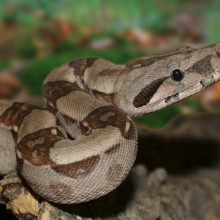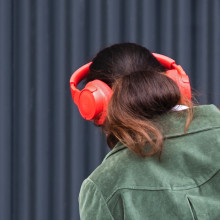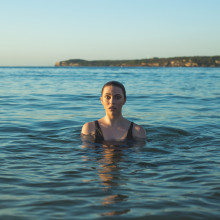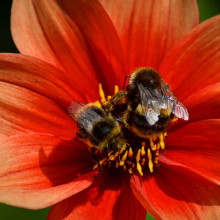We’re looking back at 2022, a remarkable year for many reasons. Whilst it is easy to be consumed by stories of conflict, climate catastrophe, and disease outbreaks, it is still important to remember that this year has been another in stellar scientific breakthroughs, a fair few of which may well help us combat the aforementioned challenges. We hope to bring you some of the weird and wonderful discoveries that were made throughout the scientific community over the past 12 months. Everything from the James Webb telescope, to James Tytko falling into a river.
In this episode

01:09 - James Webb Telescope Unfolds in Space
James Webb Telescope Unfolds in Space
Matt Bothwell, University of Cambridge
The James Webb telescope has just been launched into space. Chris Smith interviews the University of Cambridge's star public astronomer Matt Bothwell about what the telescope is and what information we hope to gain from its production & successful launch...
Chris Smith - Now, on Christmas day, you may well have been tucking into your turkey dinners, but, in South American space, scientists had some much bigger fish to fry.
James Webb Launch clip - (in french) 5. 4. 3. 2. 1. Lift off
NASA commentator - Lift off. From a tropical rainforest to the edge of time itself, James Webb begins a voyage back to the birth of the universe.
Chris Smith - Now that was NASA's coverage of the launch of its Arian-5 rocket that was carrying the $10 billion James Webb space telescope which, we are told, will enable us to see the universe like never before. Here to tell us what is in store for us is the University of Cambridge's public astronomer and author Matt Bothwell. Matt, was it Turkey for you or telescope? Were you watching it?
Matt - I was watching; it was all about the telescope for me. I was glued to the TV and, to everyone that was passing by, I was frantically showing them the exciting things happening. It was amazing. Did you watch it?
Chris Smith - I was enjoying my turkey too much. But it did get off the ground.
Matt - It did and it got off the ground absolutely beautifully. I think one thing that me along with all the other astronomers in the world were hoping for was a really successful launch, because the more fuel remaining for James Webb, the longer its potential lifespan. It turned out that the launch went so perfectly, it's going to massively exceed its 10 year lifespan. We're going to get a very long time of exploring the Universe with James Webb.
Chris Smith - How does it work? And what's it actually going to do?
Matt - The telescope is an infrared telescope, so it gets compared to the Hubble space telescope quite a lot. I think a better comparison with it is the Spitzer space telescope. It's a bit less well known, but it is an infrared telescope that's going to be taking photos of the universe in these long wavelengths of light. The difference between James Webb and Hubble is that James Webb is much further away, while Hubble is orbiting around the earth. James Webb is going to be beyond the moon, about 1.5 million kilometres away, where it's nice and cold and dark to get this very good infrared view of the universe. It's going to spend 10 years or more exploring all kinds of things from the atmospheres of exo-planets to the first stars that switched on in the universe.
Chris Smith - There's no risk of it being broken? Its predecessor, the Hubble, was launched and then, unfortunately, it was discovered to have some flaws that required a space walk to fix. We don't think that's going to happen here?
Matt - Hopefully that won't happen. I wish there was no risk of it being broken. Unfortunately, James Webb has an awful lot of potential failure points that might end up with a non-working telescope. The problem is, of course, it being so far away and not orbiting around the Earth: there's no chance to fix it. Luckily, at the time of recording, about 75% of all the risk involved in James Webb's deployment has been passed with flying colours. We are well on the way to a perfectly working telescope, but we're not out of the woods just yet.
Chris Smith - Speaking of working, when are we going to start to see data come back, some images that we can analyse?
Matt - It's going to be a little while to be honest. So James Webb is going to spend the next few months cooling down to operating temperature and then hopefully, by spring or summer 2022, we'll start to get some nice, pretty pictures back.
Chris Smith - And what are the big questions they'll be asking with it?
Matt - James Webb has a few different science goals. One of them is to explore the atmospheres of exoplanets and look for various things including what we call 'biomarkers'. These are signatures for potential organic processes going on in these exoplanets. Another one, which is very near and dear to my heart as it's my own research area, is the study of very, very ancient galaxies that existed early in the universe. James Webb is designed to see some of the first stars that ever lit up the dark in the cosmos. It's something we've never seen before. All kinds of things that are just completely on the cutting edge. It's all incredibly exciting.
Chris Smith - Well, let's see when we get you back this time next year; you can tell us what has been seen so far. It's a pleasure to have you on the program. Thank you very much, Matt Bowell, Cambridge University's public astronomer.

05:36 - Atomic clocks measuring time in millimetres
Atomic clocks measuring time in millimetres
Jun Ye, University of Colorado
CS Lewis once said “The future is something which everyone reaches at the rate of sixty minutes an hour.” But is that always true? While it certainly seems that time runs slowly whenever I’m in a boring meeting, physics tells us that in fact, the passage of time is not as constant as we once thought. Professor Jun Ye and his team at the University of Colorado are building incredibly precise atomic clocks to try to measure these distortions in time, as Robert Spencer found out...
Robert - In the 2014 movie Interstellar, the protagonists visit a planet deep in the gravitational pull of a black hole. Despite spending only a few hours on the surface, when they return to their colleague in a spacecraft, they find 2 decades have gone by.
Jun - People find that hard to believe; That time is all relative. There's no absolute time.
Robert - It's called time dilation and it all depends on where you're standing. The key is gravity.
Jun - Space and time are interconnected. When we get close to a massive body, both space and time will be curved.
Robert - That massive body could be a planet or a star. Curved space causes objects to fall towards the body, like a ball falling to the ground or a spacecraft into a black hole. The curvature of time is more mind boggling.
Jun - As you approach a massive body, the time that you measure will slow down.
Robert - It's all the results of Einstein's theory of general relativity. But it's not just a bunch of equations on a Blackboard or a plot point for sci-fi.
Jun - This was a theory, however it's being tested over time and is found to be consistent with experimental findings.
Robert - To test this theory, all you need is to take a clock to a place with weaker gravity and one to a place with stronger gravity and compare how fast they tick. For example, objects in orbit will clock up a different amount of time to us on the surface of the earth.
Jun - And the atomic clocks on board of satellites need to take into account of this time dilation effect.
Robert - In fact, if they didn't GPS would stop working in a matter of hours. But we don't need to go to a black hole or even into space at all to measure this effect. If I put a clock upstairs in my living room and one downstairs in my bedroom, there's a difference.
Jun - A clock downstairs will tick slower than a clock upstairs because downstairs is closer to the center off the earth.
Robert - And that's why I was late to work this morning. My alarm was delayed due to relativistic effects.
Jun - That's not necessarily true.
Robert - No, perhaps not. The effect would be so tiny that we wouldn't be able to detect it. Or could we? Jun Yee has been building the world's most precise clocks and he's gotten pretty good at it. Unlike clocks we may think of, which use the ticking of a pendulum to measure time, Ye's clocks use the ticking of electrons around atoms.
Jun - The atom we use is called a strontium atom.
Robert - They use lasers, shooting, very precise photons at these atoms to interrogate them.
Jun - We can use the frequency of the photon as a handle to tell the time.
Robert - And with high accuracy in measuring time, comes the ability to measure the slightest of changes in gravity. In fact, rather than needing the tens of hundreds of miles to satellites or the few yards to upstairs, Ye's team can measure the difference in gravity between two clocks separated by...
Jun - Just a mere millimeter.
Robert - Yes, that's right. 1 millimeter. The difference in the speed of time here is close to nothing. Each second, the lower clock loses.
Jun - 0.0 0 0 0 0 0 0 0 0 0 0 0 0 0 0 0 0 0 1 seconds.
Robert - That's 19 zeros.
Jun - This is incredibly precise.
Robert - But Jun Ye and his team are not satisfied with simply measuring gravity and time to this level of accuracy. By measuring the curving of space itself, he hopes to build tools with very real applications.
Jun - You can turn that into geological survey tools to sense the change in Earth.
Robert - By measuring how the mass moving underground distorts time itself. He hopes to be able to predict volcanic eruptions or measure glacier's melting. Or perhaps we could measure changes in gravity not caused by normal mass.
Jun - We may be able to shed light on the mysterious matter called dark matter. It's in our universe, but has eluded our detection.
Robert - Perhaps the most incredible is that when you start measuring gravity on such small scales, you start to probe the relationship between general relativity and quantum mechanics.
Jun - Quantum mechanics describes the microscopic part of the world. How atoms, photons & electrons evolve. General relativity is typically associated with the macroscopic view of the world.
Robert - Getting these two theories to play along together has left physicists scratching their heads for decades. Now measuring the intersection of these models seems within reach.
Jun - It will be fantastic if we can start to connect the very microscopic world of quantum mechanics with the very macroscopic world of general relativity.
Robert - The gravity of this discovery cannot be understated. It may bend our understanding of atoms, space, and time itself. Or perhaps it'll just confirm what we thought to higher and higher precision, or something in between. It's all relative.

10:51 - Can social media spread tics in teens?
Can social media spread tics in teens?
Dr Jessica Frey, University of Florida
A strange new trend has been reported by psychiatrics around the world: an increase recently in the number of teenagers with new tic-like behaviours. This has become particularly marked since the pandemic kicked off, and it coincides with a surge in social media and online video consumption. So scientists suspect that some people susceptible to tic conditions, like Tourette's, when exposed to videos of others with tics, can develop them themselves. Julia Ravey reports...
Julia - I'm just on TikTok and I'm looking up the # for Tourette’s. #Tourette’s has 5.5 billion views. Some of the top videos are an individual with Tourette’s, trying to do a COVID test. An individual, trying to drink a Coke. There's also a video here of a young girl with these jerk-like motor movements, who's asking, “Why is this happening to me?” This looks like an individual who has recently developed tic-like behaviours. There's no doubt that these videos are raising awareness of what it is like to live with tic-like behaviours, but are they having an impact beyond that? Jessica Frey from the University of Florida told me what they've been seeing in their clinics over the past year or so.
Jessica - Increased onset of tic-like behaviour and there is a concern that there is some social media influence involved in the onset of some of these tic-like disorders. One of the things we're seeing is a lot of the patients that come to us with these new onset tics, they're mimicking a lot of well known social media influencers. They have the same exact or very similar tics to the ones that they've seen in the videos.
Julia - That have been historical incidences of functional conditions spreading through populations.
Jessica - There was something called 'mass hysteria' where one person got some sort of thing and then everyone in the school got the same type of thing. That's on a much grander scale now with social media use because it's everywhere like viral content going worldwide.
Julia - Being exposed to this content with viral videos of tic-like behaviours could influence those who already have tic-like conditions or are susceptible to them.
Jessica - The tricky part of course, is that people who have Tourette syndrome or organic tics have a very common manifestation if they see people with tics that can actually be a trigger for their own tics and make them tic more.
Julia - Since the pandemic, with more teens being isolated and online, the occurrence of people coming across tic-like behaviour videos has no doubt increased, which could be a good or a bad thing. Jessica and colleagues are now trying to understand if social media is impacting tic-like behaviours, and have started with a small study, looking at the link between social media usage and tic severity.
Jessica - We did see some correlative data between the social media use as well as tic severity. There was no correlation between social media use and tic frequency. What was particularly interesting was only 5% of participants actually reported using social media to look up things related to tics and Tourette syndrome.
Julia - This was a surprise.
Jessica - Because our hypothesis going into this was that if you're going to be watching more videos on social media related to tics and Tourette syndrome, that may generate more severe or more frequent tics. We did see a correlation, but don't really have an explanation for the causation quite yet.
Julia - These results can be hard to untangle given that stress is a known influencer of increased tic-like behaviour.
Jessica - Given the pandemic and the increased social media use, which one is it? Which came first? The chicken or the egg? Is it the anxiety's driving the tics? Is it the social media use? Is it the pandemic? Is it one of those causing the other? We don't really know.
Julia - While larger studies go on to unpick this, Jessica and others have seen one technique, which has been found to help reduce tic-like behaviours in some instances.
Jessica - Anecdotally, we've seen that if we educate patients about where they're getting their information from and they stop and reduce their social media use, a lot of times the tics get better.

15:37 - Endurance discovered intact after a century
Endurance discovered intact after a century
John James & Adrian Glover, Natural History Museum & Mensun Bound, Oxford University
As we speak, the research vessel S.A. Agulhas II is steaming back to port. Aboard is an international expedition tasked with finding the wreck of the ship Endurance. The project is led by John Shears, with over 25 years of experience working in the polar regions with the British Antarctic Survey and the Scott Polar Research Institute at the University of Cambridge. Recently they’ve struck gold, as he explains to Robert Spencer. But to understand this find, we have to cast ourselves back to story which began over a hundred years ago...
Radio announcement - Men wanted for hazardous journey. Small wages, bitter cold, long months in complete darkness, constant danger, safe return doubtful, honour and recognition in case of success.
Robert - So ran the apocryphal advertisement calling for adventurers to join Earnest Shackleton on his fateful mission to cross Antarctica. Fresh out of St. John's College Cambridge, physicist Reginald W. James answered the call as his son, John recounts.
John - My father was visiting a friend in part of Cambridge that he'd never visited before. When somebody stuck his head out of a window and said, "Hey, Jimmy, do you want to go to the South Pole?"
Robert - After a brief interview with Shackleton where he was asked. Among other things, if he minded losing any toes, James and 27 other men set sail on the ship, Endurance.
John - The Endurance was actually a yacht that was built to take wealthy tourists hunting polar bears in the Arctic.
Robert - Pressed into this new scientific service, and despite the concurrent outbreak of the First World War, Endurance set sail from south Georgia for the Weddell Sea. The weather was rough and experienced 'sea-hands' had advised Shackleton to wait.
John - Shackleton said, 'No, we are going to go' in spite of the advice from the waiting captains.
Robert - It wasn't long before the ship was stuck in ice. Endurance broke free several times, but eventually the flow held it fast. The decision was taken to spend the winter in the ship and to try and complete the expedition the next year, but the elements would have different plans. Nonetheless, RW James got to work with his experiments.
John - There's a picture of him taking observations under the stern of endurance. He was doing magnetic observations, but he got very interested in the navigation side of it.
Robert - They observed eclipses of the stars by the moon, so-called occultations to maintain the time on their clocks, critical for navigation in the early 20th century. 9 long months passed.
John - But then, suddenly on Sunday afternoon, the ice opened, and it went down like a stone.
Robert - Endurance sank, 3000 meters to the bottom of the Antarctic Sea and into another world.
Adrian - The deep Antarctic is quite rich in biodiversity. You have a big range of invertebrate life, animals without backbones. For example, all kinds of sponges and corals and sea squirts. And then you have quite a high abundance of things like starfish and sea cucumbers and lots and lots of small worm-like things and molluscs in the sea bed as well.
Robert - Adrian Glover from the Natural History Museum has been studying Antarctic sea environments for years.
Adrian - All those animals are typically eating food, which has fallen from the surface layers of the ocean.
Robert - In any other waters, the sinking endurance would be part of that food chain.
Adrian - Wood gets eaten by these peculiar animals called ship worms.
Robert - Experiments run by Glover published in 2013, showed that ship worms were absent in these seas. Partly due to a lack of natural food and partly due to the strong circumpolar currents that act as a buffer between these waters and the rest of the Earth's oceans. Thus hope was high that the Endurance, if ever found by an expedition, would be in good condition. Earlier this year, such a mission set sail on the S.A. Agulhas II, a research icebreaker operated South Africa. The only clue was the rough last recorded position of the ship by his captain aided by James's timekeeping as the director for exploration, Menson Bound explains.
Menson - It wasn't like 'X marks the spot' at all.
Robert - They broke the search area up into sectors.
Menson - Eventually, just by really working in a very strict regiment manner, covering one box, then the next, then the next, we found the Endurance.
Adrian - The pictures are just remarkable. It's just sitting on the sea floor.
Menson - The ship is there. It's intact. You can see the paperwork. It's it's as good as that and doesn't get any better. It is a beautiful wreck.
John - It is quite emotional to see it again.
Robert - John's brother Viv describes a photo he has of the ship from his father's ordeal.
Viv - I'm looking at it on my wall here, right now. It just hangs there and it looks exactly the same, what we saw on the floor of the sea and what I can see on the wall here.
Menson - By definition, life after this has got to be kind of downhill.
Robert - The 28 men watching endurance sink in 1915 might have agreed. With little hope left, they set out across the frigid waters in the ship's lifeboats. They made land on Elephant Island before Shackleton and a small crew went further on to South Georgia. It's an epic tale of survival as frigid months passed for the men awaiting rescue. They were besiege by frostbite, heart attacks, mental breakdowns, and a diet almost entirely consistent of seals and penguins. Eventually at the end of August 1916, Shackleton returned on a Chilean Navy tug boat and rescued the crew. Over two years had passed since the Endurance sailed and despite the ordeal and having to shoot this sledding dogs and ships cat, not a single man perished. RW James would go on to become vice chancellor of the University of Cape Town, and two of his students would win Nobel prizes. But the ship that could so easily have been as grave rests serenely at the bottom of the Weddell Sea, almost untouched sailing into immortality.

21:15 - How boa constrictors avoid self-suffocation
How boa constrictors avoid self-suffocation
John Capano, Brown University
Now to another piece of animal news. When snakes like boa constrictors wind themselves around their potential lunch, their aim is to squeeze sufficiently hard that blood cannot get back to the prey animal’s heart, so it passes out, making it easier to swallow whole. But the snake’s got a problem: by squeezing that hard, it’s also potentially stopping its own lungs working, meaning it should be at risk of asphyxiation, shouldn’t it? From Brown University, John Capano explains to Chris Smith…
John - We were really interested in understanding whether or not snakes could actually breathe when they're constricting, because they're using their ribcage to kill another ribcage. Similarly, when they eat something, their ribcage expands. We've all seen snakes with really big food items in them and we were wondering, 'can they actually breathe when their body is swollen that wide?'
Chris - It sounds like a pretty obvious thing, but how do snakes breathe?
John - Snakes breathe with their ribcage. We as mammals are actually special in that we also use a diaphragm, but snakes and lizards only use their ribcages. They rotate the ribs, they make their chest bigger which then causes a pressure change, which then causes air to rush into their lungs.
Chris - And so how did you investigate what the snakes were doing then?
John - We originally were just doing some observational work. We were just watching snakes, constrict and feed, and we noticed that they were breathing with a different part of their body when they were constricting or feeding relative to when they were just hanging out in the cage at rest. It started with some electromyography called EMG. It's a technique that lets us measure the electrical pulses, running through a muscle. We found that the muscles that control breathing and pull the ribs, snakes can turn them on and off in different sections of their body with pretty good control. But that really didn't give us the resolution to answer the question we wanted. Then I actually applied to grad school and went to Brown in order to use this technique, X-ray reconstruction of moving morphology. It lets me look inside of an animal and see how the bones are moving inside a living animal. When I did that, I was able to use a kind of an experimental setup to prevent rib motions in one part of the body and then see if the snake would then shift it somewhere else. Analogous to what would happen during constriction or eating something really big. But we did a really controlled experiment where we could replicate it really easily too.
Chris - So what do they do then in order to avoid themselves asphyxiating when they're constricting things? How do they do it?
John - What we found is that snakes have pretty long lungs. In boa constrictors, their lungs are about 30% of their body length. In other snake species, they can go up to like 70 or 80% of their body length. But in these boas they have the front part of the lung where gas exchange happens, and then the back part, which is just kind of a bag. They normally will breathe in the front part. But then when we put the cuff on the front part and we compressed it down, they stopped using those ribs entirely. They just started breathing with the back part, which is really amazing because they're actually ventilating with the back region. They just switch and start breathing further back down the tube and drawing air through that part of the lung in the front, even if that part of the body is doing something else.
Chris - Is there not a sort of 'a chicken or egg' situation here then? Because in order to do this sort of behaviour that had to evolve for them to be able to do that in the first place, which then meant they could feed this way. How do you think this behaviour appeared in the first place?
John - That's the real difficult question of this study. It's really hard to tell which came first, the chicken or the egg in this scenario. Because you're right. Constriction and large spray ingestion require you to be able to breathe while you're doing them, so it would be really difficult for early snakes to exaggerate these behaviours to eat prey that's 100% their own body size. It's like me eating a cheeseburger that weighs 180 pounds in one bite. That would be really difficult if you couldn't already breathe while doing it. We think that this modular lung ventilation mechanism either preceded constriction in large prey ingestion or evolved in concert with it. Then the feedback of being able to breathe a little bit better, allows you to maybe constrict something a little bit bigger and then eat something a little bit bigger and then the feedback of having that ability would then allow you to exaggerate these traits even further. Considering that snakes are literally just a tube of ribs and that they really have this fine rib control, it may also be possible that this rib control may be one of the earlier traits of snakes. This ability to move ribs all along your body in order to push into the environment in different ways; That may have been turned into a ventilation mechanism, that may have come from a ventilation mechanism. But just because of the way snakes work, I think that this rib control thing was probably a really early trait within snake evolution. It's hard to tell which one came before the other ones, but maybe some future work will figure that out for us.

26:07 - Why are senior citizens more social?
Why are senior citizens more social?
Paul Zak, Claremont Graduate University
Oxytocin is the brain's hug hormone. It helps us bond with our babies and lovers and makes us more inclined to trust others. Interestingly, as Claremont Graduate University's, Paul Zak, has been showing the older we get the more of it we make and this he speculates means we tend to be happier with our lot. As we grow older, it also means we feel a stronger urge to connect with others. Bearing this in mind, our own James Tytko experienced the sudden urge to call someone very special to him...
James' Grandmother - Hello?
James - Hi grandma. How are you?
James' Grandmother - Who? I'm all right.
James - It's James.
James' Grandmother - I know James, how are you?
James - I just wanted to call to see how you were.
James' Grandmother - It's very nice of you James. Thank you very much.
James - No, no worries at all.
James' Grandmother - I'm not too bad, but you don't sound like James.
James - Why'd you say that it would be because I'm on the studio microphone, probably. Paul Hacken his team have been showing that as you age your brain trains to release more oxytocin and through further reinforcement from positive social interactions, you have further desire for these behaviors. I asked him how they managed to show this.
Paul - Many neuroactive chemicals like testosterone, estrogen decline with age. We want to see what the release of oxytocin would do. So we measured the change in oxytocin, in blood, after a short video, people aged 18 to 99, and then related that change in oxytocin to a variety of behaviors to understand not only is the release changing with age, but is it affecting behavior? And in fact, we found that the older people were, the more oxytocin they released and the more helping behaviors they engaged in.
James - You said you were showing a video to a hundred people. What exactly was the video? And how did you know that it was a sort of oxytocin inducer.
Paul - There's a video we've studied extensively in my lab for the last 15 years, and many other people now have used it as well. It's a really consistent way to induce the brain to make oxytocin. There's a video of a father and his two year old son, the son's dying of brain cancer. It's super sad. It's very sweet and warm. And then we gave people in addition a chance, since we were torturing them by drawing their blood, we paid them. We give them a chance to donate some of the earnings to the research hospital that had produced the video. Then we went further, but we also looked at the change oxytocin related to previous prosocial behaviors. In this case in the last year, how much people had donated money, time and goods to charity. And it's the first time we've shown the acute production of oxytocin is related to retrospective prosocial behaviors. And that's important because it tells us that the change in oxytocin may in fact, be tuning up based on your previous history of behavior. In other words, you can train your brain to release more oxytocin by engaging in more helping behaviors. So there's a key takeaway here for, for younger people or people of any age, which is if you have a habit of connecting to others, of helping others, then you're training yourself potentially to be a better oxytocin releaser. The more you release oxytocin, the greater satisfaction in life people have.
James - We've just gone past Easter and and pass over, Ramadan's still ongoing. So do you find that your work is sort of consistent with these religious traditions?
Paul - I think religious traditions have survived for thousands of years because there's some ancient wisdom captured by them. And what we're finding here is the underlying neurologic basis for that ancient wisdom, which is that we can live more fulfilled, happier, more satisfied lives by being a service to others. Oxytocin does a couple of interesting things in the brain. It reduces physiologic stress. So that means we have potentially better cardiovascular fitness. It also improves the immune system. So by serving others, by connecting to others, we're actually improving our own mental health, but physical help as well.
James' Grandmother - You hear that now James?
James - I do hear you.
James' Grandmother - I could smack your bottom.
James - You could.
James' Grandmother - I could James.
James - Only if I deserved it. I hope.
James' Grandmother - So. Goodbye then James behave yourself.
James - I will do have a nice day.
James' Grandmother - God bless James. Bye bye, dear.
Harry - Wasn't that really sweet James Tytko grandmother there. James was also talking to Paul Zak that study was published in the journal Frontiers in Behavioral Neuroscience.

31:32 - Teens respond less to Mum's voice
Teens respond less to Mum's voice
Dan Abrams, Stanford University
As the parents of Harry Enfield’s character “Kevin” knew only too well, when you talk to a teenager, sometimes it can feel like your words are going in one ear and out the other. And as a teenager yourself, you may have felt like interacting with someone else was infinitely cooler than listening to your parents. Now a study published this week in the Journal of Neuroscience suggests that this selective tuning-out may actually be biological. Julia Ravey heard how from Stanford’s Dan Abrams…
Dan - We brought in a cohort of 13 to 16 year olds, and we brought in their moms, and we recorded their mom saying these very brief nonsense words:
Test audio clip - Key-butt-eye-schult.
Dan - And then we had their brain activity measured using FMRI when they heard both their mother's voice:
Test audio clip - Key-butt-eye-schult.
Dan - And unfamiliar female voices saying the exact same thing. But the mother said:
Test audio clip - Key-butt-eye-schult.
Dan - And, in contrast to what we saw with the younger kids, in adolescents we saw the exact opposite response, which is a greater reward response in response to unfamiliar voices compared to mother's voice. We saw this kind of switch.
Julia - Was that what you expected to see compared to the younger children?
Dan - I wish I could say that I saw this coming. Sometimes science works like this, where you stumble onto a really cool result. We think it's evolutionarily adaptive. We think that kids, at some point, need to build their own life, build their own social network, and make their own social world. And we think that the biological process needs to occur by which kids are required to leave their family and their immediate caregivers.
Julia - After learning about Dan's work, I had to get a first-hand assessment of my own teenage ears from none other than my mum, Shell: When I was a teenager, did I ignore you?
Michelle - Honestly, I can't think of a time that you did ignore me, to be honest. Maybe at the age of three you started to want to go your own way, you were more interested in other people then, really. You used to have a pram and you used to face me and used to have your head on a swivel to see everyone going past. But I wouldn't say you actually ignored us. I think you were a very good teenager, to be honest.
Julia - Did you feel like what you were saying, I wasn't listening to you?
Michelle - I feel that more now, really. You're in planet Julia, aren't you?
Julia - Well, yeah, this is very true, but I was going to apologise if you felt like that. But then I was gonna say, "It's biology." So, I apologise for biology.
Michelle - Don't be blaming biology. Wasn't that a song by - what was it - Little Mix?
Julia - Girls Aloud.
Julia - While we debate Noughtie's pop groups, it seems I've always ignored my parents. But for those living with teens now and who are struggling with this, and for teenagers themselves who are being told off for not taking in every word their parents say, I asked Dan if he had any tips based on his findings of how to handle this communication mismatch.
Dan - I think an important message is that it's easy to malign adolescents for not listening to their parents or for tuning out their parents. And, I think as adults, we can all look back on that and say, "Well, I wasn't entirely trying to block my parents out. I was just living my life and focusing on my friends." Adolescents tune into these new social partners, but it's not personal. This is just where their mind is going and this is just what their brain is doing. Parents should know that this is a natural part of adolescent development.
Julia - When we think about our own behaviour, and what dictates what we do, when we think about listening to someone, we think about the words and the instruction, not necessarily the voice itself. I think it's really interesting that your study has shown it's not the words, or the instruction, or even the emotion, it's just who's speaking.
Dan - Yeah. I think it's easy to take voices for granted: they're everywhere. We argue that voices are among the most pleasurable stimuli that we have in our everyday lives. They help people feel connected and part of a group and part of a family. It speaks to how important it is to hear each other and to connect with each other in natural ways that are without our devices and without texting and all the like.

35:58 - Wild swimming
Wild swimming
Simon Crowhurst, Nicky Blanning, Alex Buxton
Harry Lewis and James Tytko prepare for a dip in the River Cam, Cambridge. Down a quiet strip for the river, trees overhang the water and the occasional punter drifts downstream. They are joined by Simon Crowhurst, Nicky Blanning and Alex Buxton...
Harry - That was quite impressive, James. Are you gonna take the stairs?
James - The slow way in?
Harry - I think there was really quite a stark difference between the way you got in, James, compared to Nicky, Alex, and Simon.
James - Definitely. How long until I acclimatise?
Simon - well, you need to move, give it a minute.
James - Okay. I'm good.
Harry - You're listening to The Naked Scientists and it's our summer special. So that's with me, Harry Lewis, and I've managed to drag James Tytko out the office too. Is it a hot one where you are at the moment? Because it certainly feels like it has been here over the past few days and, to beat the heat before the show kicks off properly. It looks like James and I are gonna get lured in for a wild dip in the river cam in Cambridge.James and I are joined by Nicky Blanning, gliding effortlessly through the water alongside Alex Baxton, and here on the banks with me is Simon Crowhurst. Coming down on such a beautiful day, where are we and what are we looking at?
Simon - We're on Sheep's Green. We're looking at the river Cam banked with beautiful willows. So I can see my wife and my friend, Nick, in the water swimming along and enjoying the water, which at 21 degrees is warmer than it usually is during the year. Wild swimming has increased in popularity immensely over the last few years and we've got so many applicants to join our swimming club that we can't cope with the numbers.
Harry - And you said it was 21 degrees, which sounds actually quite warm. I'm quaking in my boots about getting in Simon, because I hate the cold, but 21? How can you prove that that's 21 degrees? Well,Simon We've got a thermometer in there so we can take a look at the actual measurement. Let's do that.
Simon - So here we are with an old fashioned analog thermometer. We'll take it quickly to the water before it has chance to change. It's just under 21 degrees and you can see the liquid falling immediately as it comes out of the water because it's cooling down in the air, working a bit like a fridge.
Harry - <laugh> James, you just jumped out of the water as well. A valiant effort, I thought, when you got in. How was it?
James - Yeah, it's definitely a cliche but it's lovely once you're in.
Harry - Simon, you said that at the moment your particular swimming club's literally just got too many applicants to be able to support. Do you think that's representative of the rest of the rivers and wild swimming clubs around the UK?
Simon - Well, there's been a tremendous surge in interest and activity of wild swimming. As long as people do it safely and responsibly. I don't think it's a problem. Where people just charge into the water without any experience -without being strong swimmers - then you can have problems and people can get into difficulty very quickly.
Harry - Nicky and Alex you've swam over to us graciously, I might add. There wasn't quite the calamity of when James got in and he was holding his breath as hard as possible. <laugh> What's it like? How's the river?
Nicky - Oh, it's really beautiful. Honestly, it's absolutely gorgeous. I could stay at it for hours.
Harry - Well, I know for a fact, Nicky, you've actually been out twice today. Now you were up this morning, weren't you?
Nicky - I was, yes. I swam in the Lido and I try and swim twice a day at the moment in the summer while it's so nice.
Harry - I mean, there are health benefits that are supposedly associated with getting yourself in cold water. Obviously ,exercise is good. You're in nature, so it's a little perk for your mental health, isn't it? Are these things you think about or is it just the fact that, you know, I've got a bit of extra energy and I'm up nice and early. Why not get out there and into the world?
Alex - It becomes an addiction. I think Nicky would probably agree with this, an addiction. It's like your daily fix of something that's you know, it's a good addiction to have, I hasten to add.
Simon - It's one that has a positive effect on your physical and your mental health. I find it punctuates the day really well when I've been for a swim, it almost doubles the enjoyment that you get out of the day
Harry - On a day like today, it makes complete sense to make use of it, seeing as it's on the doorstep. Are you guys coming out here when it's not warm and sunny, when it's not 21 degrees in the river?
Nicky - Yes. I think the coldest I've swam has been actually when the river's been frozen and I've cut a circle in the ice and swam round in a circle.
Harry - You can't see it, but I'm astonished. Nicky, was this witnessed by anybody?
Nicky - Yes I have photographs.
Alex - We waded through snow to get to the river and you can't even see the edge of it
Nicky - We waded through floods of water!
Alex - That's what I mean by an addiction.
Harry - And as well, this is based on swimming that's been done here historically. Isn't it? There's photos of this exact area. Taken en mass.
Alex - Before indoor pools were built, before that, everybody swam in the river. My mother was brought up in Cambridge and she learned to swim in the side river here in the 1930s. You had to swim as a child. You had to show you could swim in the shallow side river before you were allowed in the main river, and there were people actually in charge of all this.
Harry - Well, that's probably changed quite a lot today. There isn't really a body or governing body that does look after swimmers in wild rivers is there? And Imean, that brings me onto, I guess, a more general question. It's not quite the picturesque clear colorless water of the Maldives. There is a dark kind of murky green isn't it, the river Cam? <Laugh>. So do you feel safe when you get in and out? Is there any worry about the cleanliness of the water?
Simon - Yes. There are concerns about the water quality and we are downstream of water treatment plants. The water quality does vary. There are people who heroically monitor the water quality through the year. We know there are times when the bacterial load is higher. Some of that is due to release from sewage works. Some of that is due to more suspension of particles in the water when the river flow is higher and it's hard to separate out those two effects.
Harry - And how do you feel, Nicky? Is there any fear when you get in or...
Nicky - I certainly think about it more when it's flooded and there's been heavy rainfall. I think you have to be more sensible then and I tend to keep my head out of the water. It doesn't stop me swimming, but I do think about that.
Harry - Right. Well saying that I think I put it off long enough now. I better get in as well.
Harry - Go on then. Before I dip my toe in the water, let me catch you up to speed. So, the plan is that we are going on a river trip down the river Cam right into the heart of Cambridge. We'll be stopping at sites of scientific importance on the way. So hopefully we'll also get a chance to leaf through a couple of history books, too. Sport, wildlife technology, all to come. But first we better meet captain Peter, which we'll do straight after this. God, it's gonna be so cold.
James - Don't build it up. Okay. <Splashes>

43:09 - Fertiliser affects how bees see flowers
Fertiliser affects how bees see flowers
Sam England, University of Bristol
Fertilisers are critical to modern agriculture: without the higher crop yields they provide, we’d all starve. But, fertilisers are typically made using ammonia, meaning they have a significant environmental footprint in the form of greenhouse gas emissions. They also produce algal blooms in rivers, reservoirs and even the sea. Now a new study suggests that - by affecting the electrical fields around flowers - fertilisers can also alter the way that pollinating insects, like bees, see them. Bristol University’s Sam England told Will Tingle how plants generate their electrical fields, and what fertilisers might be doing to put bees off…
Sam - The electric fields around flowers kind of have two main sources that we're aware of. One comes from their interaction with the atmosphere. So these flowers are conductors to some extent in the same way that the metal in your wires and your electrical appliances at home are conductors. Actually, plant tissue is quite conductive too. Now, the interesting thing is that these plants are obviously stuck in the ground, but they're pointing up above the ground into the atmosphere. And the atmosphere actually has an electric field in it too. And when this gets really strong, that's when you see things like thunder and lightning. But even in fair weather, there is still some amount of vertical electric field in the atmosphere. What this means is that the grounded plant relative to the air around it, actually has an electric field coming off of it because it's not at the same electrical charge as the surrounding air. But also in addition to these kinds of electric fields that are generated by their interaction with the atmosphere, the plant itself also has all kinds of physiological processes going on inside it, where it's transporting ions and signaling within the plant between cells also generate an electric field external to the flower. So those are the two main sources of electric field around flowers that we know of at the moment.
Will - And how would insects such as bees use these electrical fields to detect the presence of flowers?
Sam - Something that's really cool and that we've only really discovered over the last decade or so is that a couple of different species of insects are able to detect electric fields in air. And the way that they do this is that basically hairs on their body get pushed around by the electric field. If you think about the same way as when you charge a balloon up with your hair, the balloon can kind of push your hair around. Essentially the same thing is happening with the tiny little hairs on these bees as they're entering into the electric field around flowers. And the cool thing is that it might actually provide some useful information to them. In theory they could be using it to just detect the location of flowers, but of course they have excellent senses of smell and also vision that help them do that. But something that we have discovered previously is that when a bee visits a flower, it modifies that electric field around the flower for some amount of time on the order of a few minutes. And so then a bee that comes along after that first bee might be able to detect that difference in the electric field and essentially use it as a cue as to whether a bee has visited that flower recently and that maybe the nectar might be diminished because it's been visited recently. So it might basically give these bees a bit of a clue as to whether there's a good amount of nectar in that flower or not.
Will - What is it about synthetic fertilisers that alters the detectability of these flowers?
Sam - We try to unravel this a little bit in our study, but for sure this is something where the exact mechanisms need to be delved into in a little bit more detail. We think there's probably, again, two main ways that this is happening. One is that it just modifies the electrical properties around the surface of the flower, but also in the air around it by changing things like the humidity, but also the conductivity like the electrical conductivity on the surface of the flower. And this essentially means that the electric fields travel in a different way through the material which can make them stronger or weaker. And in the case of the fertilisers that we looked at, it seemed as if they actually make the electric fields stronger, which might be quite confusing to the bees. The other way that it might be having an impact is that a lot of these harsh chemicals that are found in synthetic fertilisers can stress the plant out. And when they do this, that will basically cause the plant to start moving ions around, kind of signaling within the plant between different cells to essentially tell other parts of the plant that maybe we're in a bit of trouble here, which again, that will change the electrical profile of the flower.
Will - Finally, what would be the ramifications on insect populations and their relationship with flowers because of this discovery?
Sam - This is one of those things where there's really a huge arsenal of evidence that's beginning to accumulate that there are just so many different ways that a lot of our activity and a lot of the chemicals that we're introducing into the environment are having quite adverse effects on quite a few different species of insects. We already know that a lot of fertilisers and pesticides are quite harmful towards pollinating insects like bees. And our study really just adds another dimension to how that's happening. But of course that does somewhat optimistically open potentially new avenues for how we can try and mitigate these negative impacts in the future as we continue to develop these technologies.

48:12 - What's the nutritional value of brains?
What's the nutritional value of brains?
Jonathan Reisman answered this question...
Jonathan - Well, besides the legal and ethical questions about eating another human's brain, it's a very nutritious and very high calorie meal. The average human brain is about three pounds or about 1.3 or so kilograms, and 60% of it is fat. So myelin, which is the substance that sort of insulates all the nerves. If the nerves were wires, myelin would be the sort of rubber coating on the outside. So a lot of that fat, would provide a lot of calories, probably enough calories to last you several days — you know, if you had only one human brain to subsist on. There's also protein, various kinds of, minerals, some B vitamins as well. I don't know if the person asked for a recipe when they submitted this question, but I would go with the traditional brain sandwich preparation method. Common in the city of St. Louis, which is to slice the brain, dip it in egg, spice it, and then deep fry it before putting it on rye bread with a hot mustard for the sandwich.
Chris - Delicious. I might ask the rest of the panel for their brain related recipes. Kathryn?
Kathryn Harkup - I have a question. I remember seeing a sign once many years ago that said smart cannibals don't eat brains because of the diseases that can be transmitted and accumulates within the species because of it. Is that true?
Jonathan - Yes. The most famous example is diseases of the prion form. There's a disease called kuru , historically common in Papa New Guinea, where cannibalism was more common —perhaps in ancient times than it is now. But there was a ritual eating of people's brains after death and this prion disease, kuru, was transmitted from person to person. There's also mad cow disease or bovine spongiform encephalopathy, which can be transmitted through, I am not totally clear how common it is for it to be transmitted to humans, but eating the nervous tissue or the brain of infected animals does put you at risk. I think the risk of contracting any of those prion diseases, including mad cow or chronic wasting disease, which is very common in white-tailed deer, here in the US, the transmissibility to humans is not well documented. But certainly in the case of kuru, which every medical student in the world knows about —because it's such a unique instance. There's definitely a risk there.

51:01 - Why do black holes rotate?
Why do black holes rotate?
So in order to understand why black holes rotate, we have to understand how they form. Black holes essentially form when you have a star that collapses under its own weight. There's two main processes happening inside a star. You have gravity that's pulled all of this hydrogen and helium together, and then you have a nuclear fusion at the core that's essentially forcing all of these hydrogen atoms together to form helium and then three heliums together to form a carbon. And that's providing a lot of energy that's stopping the collapse. But eventually stars are going to run out of this fuel at the centre and you no longer have a big force outward due to nuclear fusion. So you just have gravity forcing itself inward, and that star starts to collapse on itself. Now, all of the stars that we have observed have had some sort of spin, they've all rotated. And, in physics, just like there's conservation of energy, you have this thing called conservation of angular momentum. You have to keep the same momentum over time, over everything. You have to maintain it. So when the black hole is collapsing, it's going to keep that momentum of the star that existed before it. So you have a star that's spinning much like you have an ice skater that's spinning: they bring their arms in, they spin faster. That's the same thing that's happening. You have a star that's spinning, it collapses in on itself. It still has to spin. The question of what exactly is spinning, well, you have a singularity at the centre of a black hole, and we usually say it's this infinite density thing. You have a lot of mass in this infinitesimally small space, but in reality it does have some volume. It's just so small that we can just kind of say that it doesn't. And so it is that tiny, tiny volume of mass at the centre of a black hole that's spinning. Now, we don't exactly know what is happening at the centre of a black hole and we may never know. So it's important to say that, but that's what we've theorised to have happened based off of equations and physics and all of that. But physics gets super wonky on these small scales.
Related Content
- Previous What is cellular data and what do we pay for?
- Next NASA's Dr Z










Comments
Add a comment